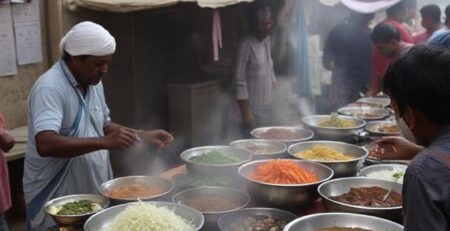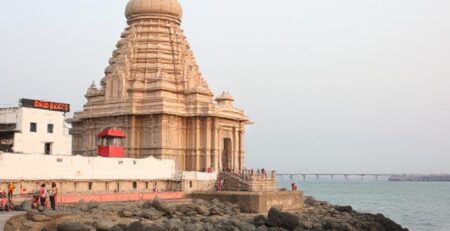Gangaikonda Cholapuram: The Magnificent Testament to King Rajendra Chola’s Gangetic Expedition – Complete Travel Guide 2025
Introduction: A Millennium of Royal Legacy
Located in the Ariyalur district of Tamil Nadu, Gangaikonda Cholapuram stands as one of India’s most remarkable archaeological treasures and a testament to the military prowess and architectural brilliance of the Chola dynasty. This ancient capital, established by the legendary King Rajendra Chola I approximately 1,000 years ago, continues to captivate visitors with its magnificent Brihadisvara Temple, rich historical significance, and unparalleled craftsmanship that earned it recognition as a UNESCO World Heritage Site.
The recent visit by Prime Minister Narendra Modi on July 27, 2025, to commemorate the 1,000th anniversary of King Rajendra Chola’s Gangetic expedition has renewed global interest in this architectural marvel. During his visit, the Prime Minister released a commemorative coin honoring the great king and announced plans for grand statues of both Rajaraja Chola and his son Rajendra Chola, further cementing the site’s importance in India’s cultural heritage narrative.
Historical Background: The Vision of Rajendra Chola I
The Gangetic Expedition and Its Significance
King Rajendra Chola I, son of the equally illustrious Rajaraja Chola I, undertook one of the most ambitious military campaigns in ancient Indian history around 1023 CE. His successful expedition to the Gangetic plains marked the zenith of Chola power, extending their dominion far beyond the traditional boundaries of South India. This victorious campaign against the kingdoms of Pala and Ganga in northern India was not merely a military conquest but a demonstration of the Chola empire’s naval supremacy and organizational capabilities.
Following this triumphant expedition, Rajendra Chola I conceptualized and constructed Gangaikonda Cholapuram as his new capital, literally meaning “the city of the Chola who conquered the Ganga.” This strategic decision reflected his vision of creating a seat of power that would rival and eventually surpass Thanjavur, the former Chola capital established by his father.
The City’s Foundation and Planning
The establishment of Gangaikonda Cholapuram represented more than just the construction of a new city; it embodied the imperial ambitions and cultural sophistication of the Chola dynasty. Rajendra Chola I envisioned a metropolis that would serve as the administrative center of his vast empire, which at its peak extended from the Maldives in the south to the Ganges in the north, and from Sri Lanka in the southeast to the Malabar Coast in the southwest.
The city was meticulously planned with the magnificent Brihadisvara Temple at its heart, surrounded by royal palaces, administrative buildings, and residential quarters for nobles and artisans. The construction of the Chola Gangam (also known as Ponneri), a massive artificial lake, demonstrated the advanced hydraulic engineering capabilities of the Cholas and served both practical and symbolic purposes – providing water for the city while representing the sacred Ganges that Rajendra had conquered.
Architectural Marvel: The Brihadisvara Temple
Temple Overview and Significance
The Brihadisvara Temple at Gangaikonda Cholapuram, dedicated to Lord Shiva, stands as one of the most magnificent examples of Dravidian architecture in India. Constructed around 1035 CE, this temple represents the culmination of Chola architectural evolution and artistic achievement. One of the largest temples in India, the Gangaikonda Cholapuram temple has Shiva as the principal deity. It is a part of the trip of the ‘Great Living Chola Temples’ along with the Airavastesvara Temple and Brihadeeswara Temple; also listed among the UNESCO World Heritage Sites.
Architectural Features and Design Elements
The temple’s design showcases a perfect blend of grandeur and refinement that distinguishes it from its predecessor at Thanjavur. The Gangaikonda Cholapuram Temple is smaller yet more refined than the Thanjavur Temple. Both are among the largest Shiva temples in South India and examples of Dravidian style temples. The architectural philosophy behind the temple reflects a more mature and sophisticated approach to temple construction.
The most striking feature of the temple is its 53-meter-tall vimana (sanctum tower), which demonstrates remarkable engineering and aesthetic sensibilities. Its 53-m vimana (sanctum tower) has recessed corners and a graceful upward curving movement, contrasting with the straight and severe tower at Thanjavur. This curved design element represents a significant departure from the linear architectural approach of the Thanjavur temple, showcasing the evolution of Chola architectural philosophy.
The sculptural elements of the temple display extraordinary craftsmanship, with intricate carvings adorning every surface. The temple walls feature elaborate sculptures depicting various forms of Lord Shiva, celestial beings, and mythological narratives that serve both decorative and didactic purposes. Scholars consider the Brihadeeswarar temple to be masculine with its straight angles and lines while the one at Gangaikonda Cholapuram is considered to be feminine with its curvilinear contours.
The Sacred Sanctum and Interior
The main sanctum houses a magnificent Shiva Linga, the primary deity worshipped at the temple. The interior of the temple is adorned with ancient frescoes and paintings that, despite the passage of centuries, continue to display remarkable artistic quality and religious significance. The temple complex originally included various smaller shrines, mandapas (halls), and other structures that formed a comprehensive religious and cultural center.
Gangaikonda Cholapuram vs Thanjavur Temple: Key Differences
Understanding the distinctions between the Brihadisvara temples at Gangaikonda Cholapuram and Thanjavur provides valuable insights into the evolution of Chola architecture and the changing artistic sensibilities of the dynasty.
Scale and Proportions
While both temples are monumental in scale, they differ significantly in their overall dimensions and proportional relationships. The Thanjavur temple, built by Rajaraja Chola I, emphasizes massive scale and imposing presence, with its 66-meter-tall vimana dominating the landscape. In contrast, the Gangaikonda Cholapuram temple, though smaller at 53 meters, achieves its impact through refined proportions and sophisticated detailing.
Architectural Philosophy and Style
The fundamental difference in architectural philosophy between the two temples reflects the generational shift in Chola aesthetic preferences. The Thanjavur temple embodies a more austere and militaristic approach, with its straight lines and angular forms conveying strength and authority. The Gangaikonda Cholapuram temple, built a quarter-century later, demonstrates a more refined and aesthetically conscious approach, with its curved lines and graceful proportions suggesting maturity and sophistication.
Sculptural Quality and Artistic Expression
The great Arulmigu Peruvudaiyar Temple at this place is next only to the Arulmigu Peruvudaiyar Kovil at Thanjavur in its monumental nature and surpasses it in sculptural quality. This assessment highlights the superior artistic achievement of the Gangaikonda Cholapuram temple in terms of sculptural refinement and execution.
Historical Context and Purpose
Each temple serves different historical and symbolic purposes. The Thanjavur temple was built to establish the Chola dynasty’s religious and political authority, serving as both a place of worship and a statement of royal power. The Gangaikonda Cholapuram temple, constructed after Rajendra’s northern conquests, serves as a victory monument commemorating specific military achievements while functioning as the spiritual center of the new capital.
Practical Visitor Information
Temple Timings and Entry Details
Planning your visit to Gangaikonda Cholapuram requires knowledge of the temple’s operating hours and visitor protocols. The temple remains open from 5:30 AM to 12 PM and 4 PM to 8 PM, allowing visitors ample opportunity to explore this magnificent monument throughout the day.
For optimal experience, Preferable visiting time will be before 10:00 a.m. and after 4:00 p.m. to avoid hot son heat. This timing recommendation helps visitors enjoy comfortable exploration while experiencing the temple’s architectural beauty in favorable lighting conditions.
Entry Fees and Accessibility
The entry fee to the temple is Rs. 10 for Indian nationals, and Rs. 250 for foreign nationals. The temple management has made efforts to ensure accessibility for all visitors, with ramps and wheelchairs available for people with disabilities.
Photography and Documentation
Photography policies at heritage sites often vary, and visitors should inquire about current regulations regarding camera usage within the temple premises. While many areas may permit photography, certain sacred spaces might have restrictions to preserve the sanctity of the worship environment.
Facilities and Amenities
Well maintained toilets and drinking water facilities are available on the left side of the entrance of the temple. These basic amenities ensure visitor comfort during extended exploration of the temple complex.
Location and Transportation
District and Geographical Context
Ariyalur is best known for the Gangaikondacholisvarar temple in Gangaikondacholapuram, the biggest Kangaikonda Cholapuram temple constructed during the reign of Rajendra–I in Ariyalur region. The temple’s location in Ariyalur district places it within a region rich in Chola heritage and archaeological significance.
Connectivity and Access Routes
The temple’s accessibility from major cities and transportation hubs makes it a feasible destination for both domestic and international tourists. It is about 40 km from mayiladuthurai. This proximity to Mayiladuthurai, a major railway junction, provides convenient access for visitors traveling by train.
The temple is well-connected by road networks, making it accessible by private vehicles, taxis, and local transportation. The journey from major cities like Chennai, Thanjavur, and Trichy involves scenic routes through rural Tamil Nadu, offering glimpses of the region’s agricultural landscape and traditional lifestyle.
Best Time to Visit and Weather Considerations
Seasonal Recommendations
The best time to visit the Gangai Konda Cholapuram Temple is during the winter months from October to March, when the weather pleasant and more suitable for temple exploration. During these months, the temperature remains comfortable for outdoor exploration, and the reduced humidity makes the visit more enjoyable.
The winter season also coincides with various festival celebrations, providing visitors with opportunities to witness traditional religious ceremonies and cultural events that bring the ancient temple to life with contemporary devotional practices.
Festival Seasons and Special Events
The temple organizes a variety of festivals throughout the year, with the Maha Shivaratri festival standing out as one of the most significant celebrations. These festival periods offer unique experiences for visitors, allowing them to witness the temple’s continued religious significance and the living traditions that connect contemporary devotees with their ancient heritage.
Cultural and Archaeological Significance
UNESCO World Heritage Recognition
The inclusion of Gangaikonda Cholapuram in the UNESCO World Heritage list as part of the “Great Living Chola Temples” acknowledges its universal value and significance to world heritage. It is part of the UNESCO Heritage site of Great Living Chola Temples. Which includes: Brihadeshwara Temple, Thanjavur (Tanjore) constructed by Raja Raja I (Raja Taja Chola) in 1010 · Brihadeshwara Temple, Gangaikonda Cholapuram constructed by Rajendra (Rajendra Chola) in 1035 · Airavatesvara Temple, Darasuram constructed by Raja Raja II in 1166
This recognition places Gangaikonda Cholapuram alongside other world-renowned monuments, emphasizing its importance not just to Indian culture but to global architectural and cultural heritage.
Archaeological Research and Discoveries
Ongoing archaeological research at Gangaikonda Cholapuram continues to reveal new insights into Chola civilization, urban planning, and medieval Indian society. Excavations have uncovered evidence of the ancient city’s layout, including residential areas, markets, and administrative buildings that once surrounded the temple complex.
These archaeological findings provide valuable information about medieval Indian urban development, trade practices, and social organization, contributing to our understanding of one of India’s most powerful and culturally sophisticated empires.
Interesting Facts About Gangaikonda Cholapuram
Engineering Marvels and Construction Techniques
The construction of Gangaikonda Cholapuram demonstrates remarkable engineering capabilities that continue to amaze modern architects and engineers. The temple’s foundation, built to support the massive stone structure, incorporates advanced techniques for soil stabilization and earthquake resistance that have enabled the building to survive for over a millennium.
The precision of stone cutting and fitting achieved by Chola craftsmen represents one of the finest examples of medieval Indian masonry. The seamless integration of massive stone blocks without mortar demonstrates sophisticated understanding of structural engineering principles.
Artistic and Cultural Innovations
The temple serves as a repository of ancient Indian artistic traditions, preserving techniques and styles that influence contemporary South Indian art forms. The sculptural program of the temple includes innovations in iconography and stylistic elements that distinguish Chola art from other contemporary Indian artistic traditions.
The temple’s influence extends beyond architecture to encompass music, dance, and literature, as it served as a center for cultural patronage and artistic development during the height of Chola power.
Water Management Systems
The Chola Gangam, the artificial lake constructed alongside the temple, represents one of the most sophisticated water management systems of medieval India. This engineering marvel not only provided water for the city’s inhabitants but also served ceremonial and symbolic purposes, representing the sacred Ganges waters that Rajendra Chola had conquered.
The lake’s design incorporated advanced understanding of hydraulics, water conservation, and environmental management, demonstrating the Cholas’ commitment to sustainable urban development.
Modern Relevance and Tourism Impact
Contemporary Significance
The recent commemoration of the 1,000th anniversary of Rajendra Chola’s Gangetic expedition, marked by Prime Minister Modi’s visit, highlights the continuing relevance of Gangaikonda Cholapuram in contemporary Indian cultural discourse. The announcement of grand statues for Rajaraja Chola and Rajendra Chola reflects the government’s commitment to preserving and promoting India’s architectural heritage.
Economic Impact on Local Communities
Tourism to Gangaikonda Cholapuram provides significant economic benefits to local communities, supporting livelihoods through hospitality services, handicraft sales, and cultural tourism activities. The site’s recognition as a world heritage monument has enhanced its appeal to international visitors, contributing to foreign exchange earnings and cultural diplomacy.
Educational and Research Value
The temple serves as an invaluable resource for students, researchers, and scholars studying medieval Indian history, architecture, and culture. Educational institutions regularly organize field trips to the site, providing hands-on learning opportunities that complement classroom instruction about Indian civilization and heritage.
Conservation Efforts and Future Prospects
Preservation Initiatives
The Archaeological Survey of India (ASI) continues to implement comprehensive conservation programs to preserve Gangaikonda Cholapuram for future generations. These efforts include structural stabilization, environmental protection measures, and documentation of artistic and architectural elements.
International cooperation through UNESCO and other heritage organizations provides additional resources and expertise for conservation work, ensuring that best practices in heritage preservation are applied to maintain the site’s integrity.
Sustainable Tourism Development
Balancing tourist access with heritage preservation requires careful planning and management. Initiatives to develop sustainable tourism practices include visitor education programs, carrying capacity management, and infrastructure development that minimizes impact on the historical site.
The integration of modern amenities with heritage conservation ensures that visitors can appreciate the site’s magnificence while contributing to its long-term preservation.
Conclusion: A Living Testament to Chola Glory
Gangaikonda Cholapuram stands as more than just an ancient monument; it represents the enduring legacy of one of India’s greatest dynasties and their contributions to world civilization. The temple’s architectural brilliance, historical significance, and cultural importance make it an essential destination for anyone seeking to understand India’s rich heritage and the remarkable achievements of medieval Indian civilization.
As we commemorate the 1,000th anniversary of King Rajendra Chola’s Gangetic expedition, Gangaikonda Cholapuram continues to inspire and educate visitors about the vision, ambition, and artistic sophistication that characterized the golden age of South Indian history. The site serves as a bridge between past and present, connecting contemporary Indians with their glorious heritage while offering international visitors insights into the remarkable cultural achievements of medieval India.
Whether you’re a history enthusiast, architecture lover, spiritual seeker, or cultural tourist, Gangaikonda Cholapuram offers an unforgettable journey through time, revealing the magnificent legacy of the Chola dynasty and their lasting contributions to Indian and world heritage. Plan your visit to this extraordinary UNESCO World Heritage Site and experience firsthand the grandeur that defined one of India’s greatest imperial capitals.










